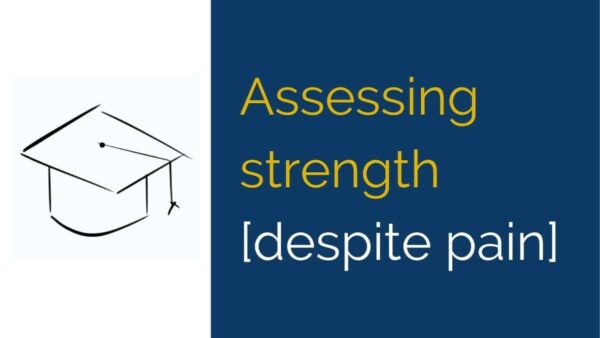You’re assessing strength to see if it’s a factor in causing symptoms, but those symptoms prevent you from reliably assessing strength…
It’s a tricky situation faced every day by Physiotherapists – pain inhibition and its effect on strength.
How do you measure leg strength when pain interferes with any functional or direct tests?
This conundrum is very common and can lead to delayed testing and diagnostic reasoning.
The typical approach is to delay assessing strength until the pain has eased, usually after 1-2 weeks.
But by then, the injured leg has reduced strength from relative rest and pain inhibition, so you can’t link the testing 2 weeks after injury to potential causes of that injury.
The unaffected side has also lost strength due to inactivity so any comparison is difficult.
And assessing strength for baseline measures is useless, so your end point of rehab is uncertain (when are they back to pre-injury/normal strength?)
The trick to assessing strength despite pain inhibition
The magic test to get around this issue is amazingly simple – calf circumference!
Max calf circumference, measured with a basic tape measure, can be done in standing or supine – it just has to be consistent between tests for reliability.
It’s unaffected by pain inhibition, although it is affected by calf muscle or calf compartment injuries…but more on that further on in this post.
Is it valid?
Calf circumference was found to have a strong positive correlation to calf muscle mass measured on MRI.
A similar correlation was also found on ultrasound comparisons.
It was also positively correlated to overall skeletal muscle mass when matched up to DEXA findings.
So your simple calf circumference measure is a quick indication of muscle mass as a proxy method of assessing strength.
What clinical information can you gain from this measurement?
Your measurement of both left and right calf muscles provides a heap of useful clinical insights.
Firstly, we have symmetry – do they match up?
Clinically, I use a 1cm difference or greater as a reliable measure of asymmetry.
Anything less than 1cm difference is either not clinically relevant or possibly due to measurement error.
Any finding of 1cm or greater can indicate strength deficits, or it may indicate swelling in the calf compartments (like from a calf tear).
Second, how do they compare to normal values?
This one is a little tricky as we only have normal values for the elderly.
But over time, you’ll get your own perception of normal based on gender, age and sport.
If you’re assessing strength in the elderly, the suggested cut offs are 33cm and 34cm for females and males respectively.
These values have been validated in Asian and South American populations, so it seems universal despite ethnicity or background.
Outcomes below these values is likely to indicate sarcopenia and should be the trigger for a whole body strength program.
Calf circumference is great as a baseline measure
One of the biggest challenges for any rehab program is knowing when you’re achieved a return to normal strength.
Assessing strength with a calf circumference measurement solves that problem.
As long as your measurement is taken soon after the onset on injury, it can provide a reliable measure of leg strength.
It becomes a target for rehab, although it only indicates a return to muscle bulk, not function.
I’d caution against using this as a return to play measure on its own – while you should be assessing strength to ensure a return to pre-injury values, there’s a vast array of other factors that need to be considered such as motor patterns and tendon elasticity.
As a way of grading injuries?
As odd as it sounds, you can also use calf circumference as a way of determining if an injury has any bleeding or swelling associated with it.
If you’re suspecting an acute calf muscle tear, look at the calf measure.
If there’s a difference of 1cm or greater, it’s likely that the calf is swollen (unless you suspect a strength asymmetry existed before the injury, which would make this measure meaningless).
A larger calf indicates swelling, meaning that you have a muscle injury of grade 2 or grade 3. If the calf is symmetrical with the other side, it could be a grade 1 injury or shin splints, which would not produce a meaningful amount of fluid.
Just remember that if there is swelling present, you can’t use the measure as a baseline for strength – however you can still use the unaffected side as the baseline measure for both legs.

